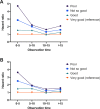Self-reported health as a predictor of mortality: A cohort study of its relation to other health measurements and observation time
- PMID: 32184429
- PMCID: PMC7078209
- DOI: 10.1038/s41598-020-61603-0
Self-reported health as a predictor of mortality: A cohort study of its relation to other health measurements and observation time
Abstract
Self-reported health (SRH) is widely used as an epidemiological instrument given the changes in public health since its introduction in the 1980s. We examined the association between SRH and mortality and how this is affected by time and health measurements in a prospective cohort study using repeated measurements and physical examinations of 11652 men and 12684 women in Tromsø, Norway. We used Cox proportional hazard regression to estimate hazard ratios (HRs) of death for SRH, controlling for pathology, biometrics, smoking, sex and age. SRH predicted mortality independently of other, more objective health measures. Higher SRH was strongly associated with lower mortality risk. Poor SRH had HR 2.51 (CI: 2.19, 2.88). SRH is affected by disease, mental health and other risk factors, but these factors had little impact on HRs (Poor SRH: HR 1.99; CI: 1.72, 2.31). SRH predicted mortality, but with a time-dependent effect. Time strongly affected the hazard ratio for mortality, especially after ten-year follow-up (Poor SRH HR 3.63 at 0-5 years decreased to HR 1.58 at 15-21 years). SRH has both methodological and clinical value. It should not be uncritically utilised as a replacement instrument when measures of physical illness and other objective health measures are lacking.
Conflict of interest statement
The authors declare no competing interests.
Figures


Similar articles
-
What is the impact of underweight on self-reported health trajectories and mortality rates: a cohort study.Health Qual Life Outcomes. 2017 Oct 2;15(1):191. doi: 10.1186/s12955-017-0766-x. Health Qual Life Outcomes. 2017. PMID: 28969649 Free PMC article.
-
Association between a self-rated health question and mortality in young and old dialysis patients: a cohort study.Am J Kidney Dis. 2008 Jul;52(1):111-7. doi: 10.1053/j.ajkd.2008.04.001. Epub 2008 May 29. Am J Kidney Dis. 2008. PMID: 18511166
-
Self-reported health and subsequent mortality: an analysis of 767 deaths from a large Thai cohort study.BMC Public Health. 2014 Aug 20;14:860. doi: 10.1186/1471-2458-14-860. BMC Public Health. 2014. PMID: 25142971 Free PMC article.
-
The ability of self-rated health to predict mortality among community-dwelling elderly individuals differs according to the specific cause of death: data from the NEDICES cohort.Gerontology. 2013;59(4):368-77. doi: 10.1159/000348781. Epub 2013 Apr 18. Gerontology. 2013. PMID: 23615509 Free PMC article.
-
Self-rated health in patients with rheumatoid arthritis is associated with health-related quality of life but not with clinical variables.Scand J Rheumatol. 2016 Jul;45(4):288-93. doi: 10.3109/03009742.2015.1116604. Epub 2016 Jan 25. Scand J Rheumatol. 2016. PMID: 26807489
Cited by
-
Seasonal and socio-demographic patterns of self-reporting major disease groups in north-west Burkina Faso: an analysis of the Nouna Health and Demographic Surveillance System (HDSS) data.BMC Public Health. 2021 Jun 9;21(1):1101. doi: 10.1186/s12889-021-11076-1. BMC Public Health. 2021. PMID: 34107895 Free PMC article.
-
Associations between sedentary behavior and health and the moderating role of physical activity in young people within a cross-sectional investigation.Prev Med Rep. 2023 Jul 8;35:102316. doi: 10.1016/j.pmedr.2023.102316. eCollection 2023 Oct. Prev Med Rep. 2023. PMID: 37484923 Free PMC article.
-
Health of people with selected citizenships: results of the study GEDA Fokus.J Health Monit. 2023 Mar 21;8(1):7-33. doi: 10.25646/11143. eCollection 2023 Mar. J Health Monit. 2023. PMID: 37064418 Free PMC article.
-
Impact of family doctor contracted services on the health of migrants: a cross-sectional study in China.Sci Rep. 2024 Nov 27;14(1):29510. doi: 10.1038/s41598-024-81068-9. Sci Rep. 2024. PMID: 39604578 Free PMC article.
-
Modeling Poverty and Health for Native Hawaiian and Pacific Islander and Asian Ethnic Populations.Hawaii J Health Soc Welf. 2023 Oct;82(10 Suppl 1):77-83. Hawaii J Health Soc Welf. 2023. PMID: 37901660 Free PMC article.
References
-
- Hirve S, et al. Unpacking self-rated health and quality of life in older adults and elderly in India: A structural equation modelling approach. Soc. Indic. Res. 2014;117:105–119. doi: 10.1007/s11205-013-0334-7. - DOI
MeSH terms
LinkOut - more resources
Full Text Sources

